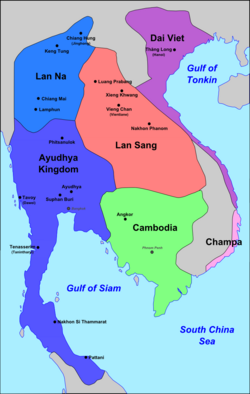Portal:Laos/Selected article/3

The Lao Kingdom of Lan Xang Hom Khao (Lao: ລ້ານຊ້າງຮົ່ມຂາວ; /laːn˥˧ saːŋ˥˧ hom˧ khaːw˥/; "Million Elephants and White Parasols") existed as a unified kingdom from 1354 to 1707.
For three and a half centuries, Lan Xang was one of the largest kingdoms in Southeast Asia. The meaning of the kingdom's name alludes to the power of the kingship and formidable war machine of the early kingdom. The kingdom is the precursor for the country of Laos and the basis for the national historic and cultural identity.
Under the reign of King Sourigna Vongsa (1637–1694) Lan Xang experienced a fifty seven-year period of peace and restoration. During the period the Lan Xang sangha was at the apex of power, drawing monks and nuns for religious study from throughout Southeast Asia. Literature, art, music, court dance experienced a revival. King Sourigna Vongsa revised many of the laws of Lan Xang and established judicial courts. He also concluded a series of treaties which established both trade agreements and boundaries between the surrounding kingdoms.
Lan Xang had ethnic diversity from trade and overland ethnic migrations. The multiple hill tribe peoples were grouped into the broad cultural categories of Lao Theung (which included most indigenous groups and the Mon-Khmer) and Lao Sung. The Lao Loum were ethnically dominant and there were several closely related Tai groups which included the Tai Dam, Tai Daeng, Tai Lu, Tai Yuan, and Phuan people.
Theravada Buddhism was the state religion of Lan Xang beginning with King Photisarath in 1527, but had been a growing part of cultural legacy since Fa Ngum. Within the villages, monasteries and towns of Lan Xang much of daily life revolved around the local temple or wat. The temples were centers of learning, and all males were expected to spend at least some part of their life in religious contemplation as a monk or novice. Kings could establish their legitimacy through supporting the sangha and caring for or constructing new temples.
Lan Xang was at the center of the overland trade routes in Southeast Asia. In the north and northwest the overland trade routes from Burma and Lanna passed through Lan Xang and Sipsong Panna toward Yunnan, where they would join with the Chinese Tea-Horse Road. Trade in Luang Prabang would flow down the Mekong to Vientiane where it could then be transported overland to the headwaters of the Nan and Chao Praya rivers, or overland by ox cart or elephant over the Khorat Plateau to Roi Et.
